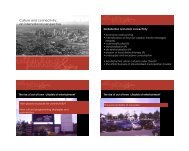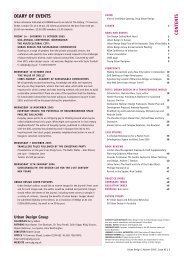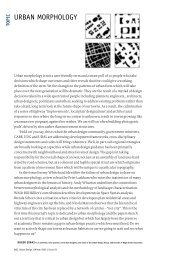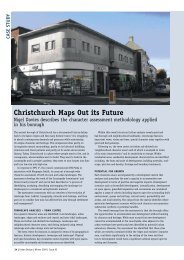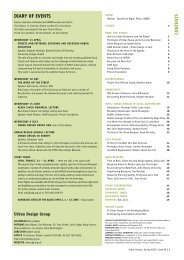topic - urban-design-group.org.uk
topic - urban-design-group.org.uk
topic - urban-design-group.org.uk
Create successful ePaper yourself
Turn your PDF publications into a flip-book with our unique Google optimized e-Paper software.
NEWS AND EVENTS<br />
Call for Home Zone Designers<br />
Are you involved in the <strong>design</strong> of a<br />
new-build home zone for a developer or<br />
public sector <strong>group</strong>?<br />
A <strong>group</strong> of <strong>design</strong>ers and<br />
campaigners is currently setting up a<br />
website with the support of the IHIE<br />
(Institute of Highway Incorporated<br />
Engineers) to show good practice and new<br />
<strong>design</strong> ideas for new build home zones,<br />
and would be interested in your work.<br />
Following the production of Mike<br />
Biddulph’s HomeZones - A Planning<br />
and Design Handbook (JRF 2001) and<br />
the IHIE Home Zone Design Guidelines<br />
(2002), many <strong>design</strong>ers and clients<br />
identified a need for a showcase of best<br />
practice new build home zones, and<br />
so want to hear about proposals and<br />
ideas that have helped to overcome<br />
typical problems and concerns raised<br />
in <strong>design</strong>ing home zones. The <strong>group</strong><br />
meets bi-monthly with the next<br />
meeting in November, but contributions<br />
and material can also be submitted<br />
electronically. Please contact louise.<br />
thomas@scottwilson.com if you would<br />
like to get involved.<br />
Louise Thomas<br />
UCE Launches new Urban Design Masters Course<br />
The School of Architecture and Landscape<br />
Architecture at the University of Central<br />
England in Birmingham has launched<br />
a new masters programme in <strong>urban</strong><br />
<strong>design</strong>. It is unique in the West Midlands<br />
and draws upon the area’s dynamic and<br />
award-winning regeneration schemes<br />
for its programme. The course has been<br />
<strong>design</strong>ed to tackle cultural heterogeneity<br />
and the complexity of our cities, as well<br />
as the diverse <strong>urban</strong> fabric of our cities,<br />
towns, suburbs, villages and <strong>urban</strong><br />
fringe. The core issues are sustainable<br />
development, heritage management,<br />
multi-cultural <strong>urban</strong>ism, and <strong>urban</strong><br />
regeneration and governance. The course<br />
also provides opportunities for student<br />
placements, visiting professionals to<br />
work with students and a one week study<br />
visit to a European city.<br />
The course structure allows for one<br />
year full-time study, two years part-time<br />
study, or modules taken as short courses<br />
as part of a continuing professional<br />
development (CPD) credit scheme, to<br />
give a certificate, diploma or masters<br />
degree in <strong>urban</strong> <strong>design</strong>.<br />
For further information contact<br />
noha.nasser@uce.ac.<strong>uk</strong>.<br />
Noha Nasser, Course Director, Birmingham<br />
School of Architecture and Landscape,<br />
University of Central England<br />
Forthcoming Publications: Urban Design Futures<br />
The past ten years in this country has<br />
seen the rise of <strong>urban</strong> <strong>design</strong>. From<br />
a peripheral activity of questionable<br />
relevance to the quality of the<br />
environment that was being delivered<br />
by government, local authorities and<br />
the private sector, it has taken a central<br />
position in the new agendas for <strong>urban</strong><br />
regeneration and renaissance. New<br />
legislation and guidance is reinforcing<br />
this importance. The Urban Task Force<br />
with its emphasis on an integrated<br />
approach to development, and its<br />
aspiration for an <strong>urban</strong> renaissance has<br />
helped consolidate this central role.<br />
Urban capacity studies, exploration into<br />
sustainable <strong>urban</strong> quality, guidance from<br />
government bodies reshaping the <strong>design</strong><br />
agenda have started to provide new<br />
<strong>urban</strong> <strong>design</strong> tools to enable public and<br />
private sectors to improve the quality<br />
of the built environment. The advent of<br />
CABE has reinforced this. The different<br />
regions of the country are preparing new<br />
strategies for architecture and the built<br />
environment. Urban <strong>design</strong> has moved<br />
from marginality to mainstream. The<br />
principles espoused by <strong>urban</strong> <strong>design</strong>ers<br />
over the past 20 to 30 years are now<br />
accepted as key to a better <strong>urban</strong><br />
environment. For many <strong>urban</strong> <strong>design</strong>ers<br />
much of that time has been spent<br />
proselytising, promoting the benefits of<br />
<strong>urban</strong> <strong>design</strong>.<br />
Now that the <strong>urban</strong> <strong>design</strong> messages<br />
are being accepted, an intellectual gap<br />
has emerged. Many of the ideas and<br />
principles that have become the coda of<br />
<strong>urban</strong> <strong>design</strong> are beginning to take on a<br />
patina of age. Key <strong>urban</strong> <strong>design</strong> models,<br />
such as ‘responsive environments’,<br />
have stood the test of time. Its core<br />
values have been accepted. But as we<br />
move towards greater sustainability,<br />
different ideas are emerging that are<br />
challenging some of the accepted <strong>urban</strong><br />
<strong>design</strong> norms. Much of this is occurring<br />
outside the UK in countries such as<br />
Holland, Denmark, and the USA. Urban<br />
<strong>design</strong> is at a watershed. The time has<br />
come to review progress and to explore<br />
these and other emerging ideas. Should<br />
<strong>urban</strong> <strong>design</strong> reflect the future rather<br />
than recreate the past? What are the<br />
new driving forces that will shape <strong>urban</strong><br />
living and hence <strong>urban</strong> <strong>design</strong> in the<br />
future? Are these global issues? Will they<br />
reflect issues of gender and plurality?<br />
A new book to be published by Routledge<br />
in 2005 will be based around a number<br />
of themes. These will include:<br />
• uncertainty, addressing surrounding<br />
the blurring of edges, and transience<br />
• movement, <strong>design</strong>ing for movement<br />
through cities<br />
• experience, a retailing approach to the<br />
<strong>urban</strong> environment<br />
• control, the embedding of <strong>urban</strong><br />
<strong>design</strong> as a legislative tool<br />
• sustainability and townscape.<br />
The purpose of this book is to explore<br />
new concepts, to set out the intellectual<br />
frameworks behind these ideas through<br />
a series of ‘think-pieces’ and perhaps<br />
to point the way towards a series of<br />
<strong>urban</strong> <strong>design</strong> paradigms for the 21st<br />
century. A range of contributors, some<br />
of whom will be practitioners, others<br />
new ‘conceptualisers’ and academics<br />
will explore each of these themes. They<br />
include Adriaan Gueze, Lucien Kroll,<br />
Thom Mayne, Ken Worpole, Ken Yeang,<br />
John Punter, Tim Stonor, Jan Gehl.<br />
Jon Rowland and Malcolm Moor<br />
Editors and contributors<br />
8 | Urban Design | Autumn 2004 | Issue 92



